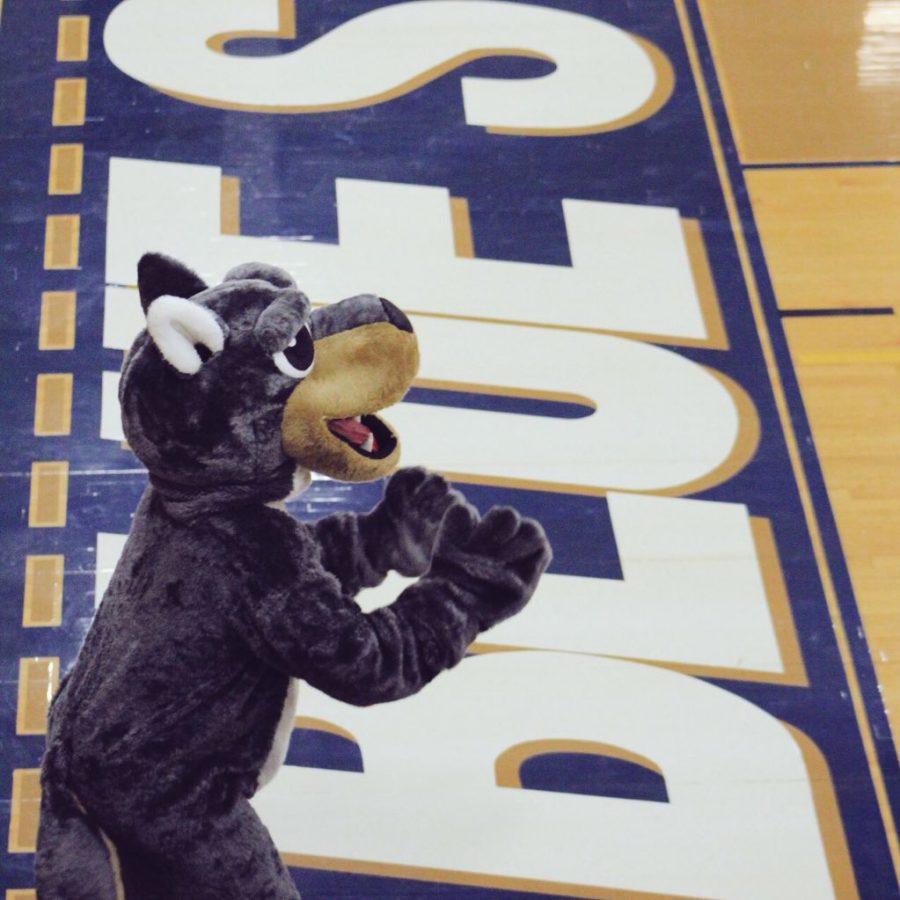Bring Lobo the Wolf back to JCU
Arts and Life Editor Claire Schuppel uncovers the archives on JCU mascot Lobo the Wolf.
May 15, 2023
If you were to walk up to any John Carroll student and ask them if they know what our mascot is, you’re likely going to get one of two responses: “I have no clue what a Blue Streak is,” or “Isn’t it a wolf or something?”
Candidly, our university does not have the same love for our mascot as larger schools like Ohio State’s Brutus Buckeye or Bowling Green’s Freddie and Frieda Falcon. This raises a few questions: what is a Blue Streak? What happened to our mascot’s marketing? What must happen to bring back that image?
Just like present day, in the 1920s, JCU did not have an identifiable mascot that fit among the ranks of other colleges; overall, the university was struggling to find their proper branding. JCU Athletics reported in 2019 that Raymond Gibbons from the class of 1924 said that the athletes running on the field in their uniforms were “tearing around like a blue streak.” From there, the nickname stuck and later became the branding for JCU.
Another, lesser known, symbol of JCU is Lobo the Wolf, which is the costume seen at athletic events in the past. According to the JCU website, “Lobo” comes from the phrase seen on our university seal, “Lobo-y-olla” (“wolf and pot”), signifying the generosity of the Jesuits. This was shortened to the “Loyola” that many associate with Jesuit universities to this day. From this, our beloved Lobo was born. The mascot was used at games and other university events until recent years, which has raised some concerns on what happened to Lobo.
Joe Ginley ’16, who has been JCU’s Sports Information Director since 2020, offered insight on where Lobo has been. During his time in undergrad, Ginley said that Lobo’s imagery was used more frequently, despite never fully incorporating the wolf into athletics, as “the costume was around a lot more, but you wouldn’t necessarily see it in official instances.” Lobo would be at games with the students in the crowd, but was seldom used in merchandising.
When discussing why JCU doesn’t use the Lobo imagery in logos or merchandise, Ginley said that the athletics department rebranded in 2020 for consistency and recognition of the Blue Streak teams and, “during that process, that was when the decision was made to stop using Lobo.”
Ginley also shared his personal thoughts on our current lack of a mascot saying, “At least for me personally, it is kind of a bummer that we don’t have that cool, cartoonish character and it’s a known thing for colleges to have.” He believes that not having the mascot is not a detriment to our branding, as JCU has a sophisticated design, but also shared that it would be cool for students to have an identifiable mascot.
Drawing comparisons between JCU’s general lack of knowledge on our mascot and how students at other Ohio universities feel about theirs could be useful in seeing what we have to change about Lobo’s lack of use.
When asked about the personal significance of Kent State University’s mascot, Flash the Eagle, alumna Alyssa Dziak ’22 stated, “I am a second generation KSU graduate and I’ve been visiting Kent my entire life with my mom, so when I entered Kent as a freshman, it was inspiring to see someone [Flash] as excited to be there as I was – until I met him in the student center and he was big and scary.”
The University of Toledo also has an interesting mascot, Rocky the Rocket. Student Sean Mahoney ’24 said that information on the mascot’s origins is not widely known on campus, but Rocky is a fundamental part of games and tailgates. “I feel like I know Rocky personally and that’s pretty awesome,” Mahoney said. “They’re just a good way to get the crowd going…it gives you a connection to them that you wouldn’t get at other schools.”
One of Ohio’s most famous mascots is Rufus the Bobcat of Ohio University who student Halle Breudigam ’24 said is “the face of OU.” She also shared that school spirit is heightened by the active role Rufus plays in their campus events. “I noticed ever since I enrolled in OU that everyone who went here is proud to be a bobcat.”
The future of Lobo is unknown, but there are a select few students who want to see his return. Class Senator Morgan Anderson ’25 is an advocate for Lobo’s return, saying, “I think that bringing back Lobo is something that would enhance the athletic experience at John Carroll and overall boost morale among students at athletic events.”
Anderson also stated that as a member of the Carroll Crazies, she plans on mentioning the importance of reintegrating Lobo back into sporting events. Since not many individuals know much about Lobo and his importance, Anderson said, “The first step in our mascot returning to campus is to make the students aware of the significance that Lobo holds!”
Ginley also stated ideas for bringing Lobo back to the students, as we have had time to establish the school rebrand. He said that Lobo could be used intermittently at games and he even proposed, “Why don’t we have a throwback day? How can we utilize Lobo here and there to create some fun with it?” The idea of bringing Lobo back has been discussed by the athletic department, and with the new Director of Athletics Brian Polian ‘97, JCU might see some mascot changes in the near future.
The Blue Streaks who are most passionate about bringing Lobo back onto the radar of JCU community members should follow Ginley’s words: “if students have ideas, they should definitely bring them forward… if someone says, ‘we should do a design contest,’ or if someone wants to make a special t-shirt, ideas are great. If folks have ideas, let’s hear them!”
If you are also a Lobo advocate, reach out to student government and send emails to the athletics department.














TheLoboDude • Jun 23, 2023 at 2:42 pm
We absolutely need the Lobo back.
mhanicak • May 16, 2023 at 2:03 pm
#BringbackLobo!